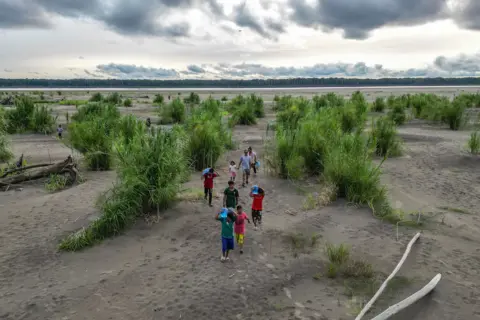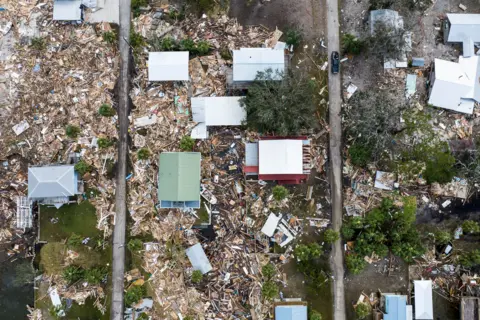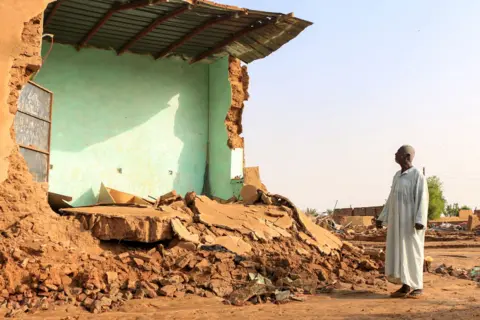A year of extreme weather that challenged billions of people

 Hasan JD/Getty Images
Hasan JD/Getty ImagesClimate change has brought record-breaking heat this year, along with extreme weather, from hurricanes to month-long droughts.
This year is expected to be the hottest on record, and new research shows that people around the world experienced an extra 41 days of dangerous heat due to climate change.
Researchers from the World Weather Attribution (WWA) group at Imperial College and Climate Central said the study shows “we are living in a dangerous new era”.
From Brazil to Indonesia we take a look at the climate events that could impact the lives of billions of people in 2024.
Billions of people suffer from heat wave
It was the year of the summer – temperature records were broken several times on land and in the sea.
Dozens of countries from Lebanon in the west to Cambodia in the east faced a prolonged heatwave in April, raising the risk of dehydration and heat stroke.
But Julie Arrighi, director of programs at the Red Cross Red Crescent Climate Centre, said the impacts are not felt equally.
“Younger people and those over 65, especially those with pre-existing health problems (are at risk) – they are less physically able to cope with extreme heat,” he said.
He said people living in conflict situations suffer disproportionately because of their housing conditions, including living in makeshift shelters, which can lead to increased heat, or disrupted water systems.
Research has shown Populations may adjust to higher temperatures over time, but even taking this into account, WWA and Climate Central scientists estimate that the world’s population could experience 41 additional days of dangerous heat in 2024 – without climate change. Compared to the world.
Dr Friederike Otto, head of WWA and senior lecturer in climate science at Imperial College London, said: “The impacts of fossil fuel warming have never been clearer or more devastating than by 2024.
“We live in a dangerous new era – with extreme weather causing untold suffering.”
 Niharika Kulkarni/AFP
Niharika Kulkarni/AFPAmazon’s lifeline dried up
Regional heat wave around the Amazon region has made it worse A natural climate phenomenon called El NinoBut researchers at WWA and Climate Central said climate change remains the driving force.
Along with higher temperatures, precipitation also decreased across much of South America. Officials in Colombia reported The level of the Amazon River dropped by 90%, severely affecting power supplies, crop yields and forest fires.
Nearly half a million children are believed to have been affected by school closures in Brazil and Colombia due to lack of drinking water. According to UNICEF.
The Amazon River is also a vital lifeline for the eponymous rainforest – supporting thousands of species and supporting the world’s efforts to combat climate change.
Dr. Regina Rodrigues, professor of physical oceanography and climate at the Federal University, said, “We fear that (climate change) could push the forest into an irreversibly dry state, which would reduce moisture flows and carbon sinks, as well. There will be loss of biodiversity.” Of Santa Catarina in Brazil.
“All of these vital processes are essential to sustaining life as we know it, not only at the local and regional level but also at the global level,” he said.
 Luis Acosta/AFP
Luis Acosta/AFPPhilippines: an unprecedented typhoon season
While some people are suffering from lack of rain, some have received too much rain.
The Philippines experienced a record-breaking six typhoons in just 30 days in October and November – this came after six months of typhoons. The country is one of the most vulnerable to these tropical storms due to its location close to warm ocean waters.
Landslides and floods caused by typhoons this season killed more than 1,200 people across Southeast Asia.
There is currently no evidence that climate change is increasing the number of typhoons, hurricanes or cyclones (the same phenomenon but given different names around the world), although research suggests it may increase their intensity. Can.
But an assessment of the climate by WWA scientists concluded that the record ocean temperatures that occurred in 2024 were “conducive” to the formation of such storms, and that climate change is likely to increase those temperatures.
Dr. Zach Zobel, associate scientist at the Woodwell Climate Research Center, who was not involved in the study, supported WWA’s view, but said: “(This season) didn’t tell us anything that we didn’t already know.” Was coming in 1.3 -1.5C (warmer) world.
“Scientists have been warning about the recurring occurrence of these extreme events for years, if not decades,” he said.
 Ezra Akayan/Getty Images
Ezra Akayan/Getty ImagesOcean temperatures fuel early storms
Even the richest countries were not able to fully protect themselves from extreme weather this year. According to research by Christian Aid, the US experienced two consecutive hurricanes – first Hurricane Helen and then Hurricane Milton – which killed more than 260 people and caused $115 billion (£92 billion) in damage.
Scientists had predicted “Extraordinary” season Due to high sea temperatures in the Atlantic, which promotes hurricanes.
But while Hurricane Beryl was the Atlantic’s earliest category five hurricane on record on July 2, there was a lull in the middle of the season before Hurricane Helen arrived.
Dr Otto told the BBC that normally large storms suck heat out of the ocean and prevent new storms from forming for a period of time, but the qualitative evidence suggests “because the entire upper ocean was extremely warm, this effect was not Happened.”
He said WWA is considering doing further analysis on this in the future.
 Chandan Khanna/AFP
Chandan Khanna/AFPHeavy rain in Nigeria, Chad, Sudan
Floods in Sudan and Nigeria in August and September showed that poorly maintained infrastructure can lead to extreme weather conditions.
Heavy rains are starting in July Widespread flooding occurred that caused several dams to collapse, killing dozens of people and forcing thousands to flee their homes.
 AFP
AFPThe report from WWA and Climate Central estimates that these heavy rainfall events have become common occurrences due to human-caused warming, and are expected to occur on average every three to 10 years.
Julie Arrighi, of the Red Cross Red Crescent Climate Centre, said: “Our studies show the need to increase preparedness for extreme weather to reduce loss of life and damage.
“We are not well prepared for life in 1.3-1.5 degrees Celsius warming.”






